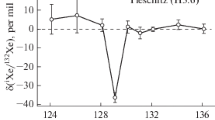Abstract
The uncertainty in the isotope compositions of the initial (primary) xenon components responsible for its measured composition in meteoritic nanodiamonds requires a more in-depth analysis of these data and modeling using different initial compositions. In this work, we analyzed for the first time the contents of xenon components in nanodiamond-enriched fractions of Orgueil (C1) and Indarch (EH3-4) meteorites. These contents were calculated assuming that Xe-HL and Xe-P6e consist of a mixture of Xe-P3 and isotopically anomalous subcomponents, designated by us as Xe-pr1 and Xe-pr2, respectively. The last two components could have been formed in the p- and r-processes of nucleosynthesis during explosion of a type II supernova. The isotope compositions of the Xe-pr1 and Xe-pr2 components were calculated assuming that Xe-P3 is an almost isotopically normal component in the Xe-HL and Xe-P6e components. Based on the calculated contents of initial Xe-P3, Xe-pr1, and Xe-pr2 components in nanodiamonds of such meteorites as Indarch (EH3-4) and Orgueil (C1), the following conclusions are made: (1) Each of the Xe-pr1, Xe-pr2, and Xe-P3 components is found in the individual populations of diamond grains with different thermo-oxidative stability. Based on the relative contents of xenon components, Xe-P3 is the major component. (2) According to the Ott model (Ott, 1969), the differences between the Xe-pr1 and Xe-pr2 components in 124Xe/136Xe and 134Xe/136Xe isotopic ratios are probably related to the limited time of formation of Xe isotopes through the decay of their radioactive precursors from the moment of supernova explosion to their capture: 1.89 hours for Xe-pr2 and 2.17 hours for Xe-pr1. It is suggested that carrier phases of Xe-pr1 and Xe-pr2 components are formed in different turbulent mixing zones of fragments of the outer and inner layers of type II supernovae.




Similar content being viewed by others
REFERENCES
D. D. Clayton, “Origin of heavy xenon in meteoritic diamonds,” Astrophys J. 340, 613–619 (1989).
A. V. Fisenko and L. F. Semenova, “Meteoritic nanodiamonds: alternative composition of xenon components,” Solar Syst. Res. 54 (3), 278–288 (2020).
J. D. Gilmour, A. B. Verchovsky, A. V. Fisenko, G. Turner, and G. V. Holland, “Xenon isotopes in size separated nanodiamonds from Efremovka: 129Xe*, Xe-P3, and Xe-P6,” Geochim. Cosmochim. Acta 69, 4133–4148 (2005).
D. Heymann and M. Dziczkaniec, “Xenon from intermediate zones of supernovae,” Proc. 10th Lunar Planet. Sci. Conf., 1943–1959 (1979).
P. Hoppe, R. J. Stancliffe, M. Pignatari, and S. Amari, “Isotopic signatures of supernova nucleosynthesis in presolar silicon carbide grains of type AB with supersolar 14N/15N ratios,” Astrophys. J. 887, 1–10 (2019).
W. M. Howard, B. S. Meyer, and D. D. Clayton, “Heavy-element abundances from a neutron burst that produces Xe–H,” Meteoritics 27, 404–412 (1992).
G. R. Huss and R. S. Lewis, “Noble gases in presolar diamonds I: Three distinct component and their implication for diamond origins,” Meteoritics 29, 791–810 (1994a).
G. R. Huss and R. S. Lewis, “Noble gases in presolar diamonds II: component abundances reflect thermal processing,” Meteoritics 29, 811–829 (1994b).
A. Kouchi, H. Nakano, A. Kouchi, and H. Nakano, “Novel routes for diamond formation in interstellar ices and meteoritic parent bodies,” Astrophys. J. 626, 129–132 (2005).
R. S. Lewis, E. Anders, and B. T. Draine, “Properties, detectability and origin of interstellar diamonds in meteorites,” Nature 339, 117–121 (1989).
R. S. Lewis, S. A. Amari, and E. Anders, “Interstellar grains in meteorites. II. SiC and its noble gases,” Geochim. Cosmochim. Acta 58, 471–494 (1994).
U. Ott, “Interstellar diamond xenon and time scales of supernova ejecta,” Astrophys. J. 463, 344–348 (1996).
M. Rayet, M. Arnold, M. Hashimoto, N. Prantzos, and K. Nomoto, “The p-process in type II supernovae,” Astronom. Astrophys. 298, 517–527 (1995).
F. K. Thielemann, M. Eichler, I. V. Panov, and B. Wehmeyer, “Neutron star mergers and nucleosynthesis of heavy elements,” Annu. Rev. Nucl. Part. Sci. 67, 253–274 (2017).
ACKNOWLEDGMENTS
We are grateful to reviewers A.B. Verchovsky and V.A. Dorofeeva for valuable comments that significantly improved the manuscript.
Funding
This work was made in the framework of the government-financed project no. 137-2019-0002 “Mineralogical-Geochemical and Cosmochemical Problems of the Formation, Differentiation, and Evolution of Extraterrestrial Matter” of the Vernadsky Institute of Geochemistry and Analytical Chemistry.
Author information
Authors and Affiliations
Corresponding author
Ethics declarations
The authors declare that they have no conflicts of interest.
Additional information
Translated by M. Bogina
Rights and permissions
About this article
Cite this article
Fisenko, A.V., Semjonova, L.F. Nanodiamond of Meteorites: Concentrations and Isolation Kinetics of Possible Initial Xenon Components. Geochem. Int. 60, 530–536 (2022). https://doi.org/10.1134/S0016702922060027
Received:
Revised:
Accepted:
Published:
Issue Date:
DOI: https://doi.org/10.1134/S0016702922060027



